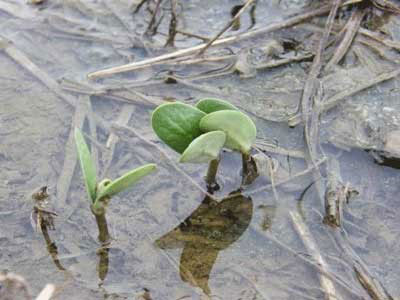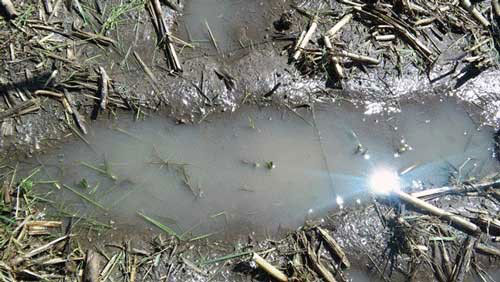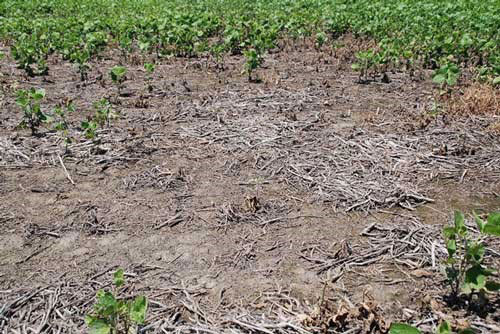Soybean planting is already under way in Kansas (51% planted), based on the USDA-NASS Crop Progress and Condition Report from May 24, 2021. However, in many parts of the state beans have gotten off to a very slow start, constrained by rain events and wet soil conditions (mainly in the eastern side of the state).

Figure 1. Soybean slowly emerging and showing lack of uniformity. Photo by Ignacio Ciampitti, K-State Research and Extension.
Wet soil conditions will slow emergence, make the soil more susceptible to compaction (limiting root growth), and cause poor plant-to-plant uniformity after emergence. Sidewall compaction occurs when soybeans are planted when the soil is too wet, immediately followed by dry weather. Soil surface crusting is another potential challenge for soybean emergence.
After emergence, how will soybeans respond to standing water and saturated soil conditions?
If soybean plants are submerged for less than 48 hours, there is a good chance they will survive. Plants can survive under water longer under cool than warm temperatures. Submerged soybean plants can survive for up to 7 days when temperatures are less than 80 degrees F.

Figure 2. Soybean seedlings under water. Photo by D. Shoup, K-State Research and Extension.
To find out whether the soybeans are damaged after the water recedes, split the stem at the tip and examine the growing point. A healthy growing point will be firm and white or cream colored. A soft, dark growing point indicates injury. In some cases, the silt coating the plant after short-term flooding can cause more injury and plant death than the water itself.
Even if the fields did not have standing water and plants were not totally submerged, waterlogged soils can cause problems if the waterlogging lasts too long. When soils are saturated for a prolonged period of time, a lack of oxygen in the roots can lead to the accumulation of lactic acid and other products of anaerobic respiration. This is the underlying cause of damage to plants in waterlogged soils where only the roots are flooded.
Injury can depend on variety, growth stage, duration of waterlogging, soil texture, fertility levels, and diseases present. Interactions of these factors make it hard to predict how a given soybean field will react to waterlogged soils.

Figure 3. Soybean seedlings under full submersion. Photo by Ignacio Ciampitti, K-State Research and Extension.
Variety differences have been reported and researchers have identified possible genes associated with tolerance to waterlogged conditions. Scientists in Missouri have screened a number of soybean varieties, subjecting them to two periods of flooding, each two weeks in duration. The average yield reduction for all varieties was 61%. Yields were reduced by 39% for the most tolerant varieties and 77% for the least tolerant. Producers should check with their seed supplier regarding information about a particular variety.
Growth stage factors
Research examining the influence of growth stage on the degree of injury from waterlogged soils has provided mixed results.
- Germination. Saturated conditions during germination can reduce successful germination by up to 40% and can inhibit seedling growth. Seeds that are further along in the germination process at the time of saturation sustain more injury.
- Vegetative growth stages. Excess water during vegetative stages usually causes less injury than waterlogging during the reproductive and grain filling stages. Short-term waterlogging (2 to 3 days) at V2 to V4 can cause yield reductions of 0% to 50%, depending on soil texture, variety, and subsequent weather. Yield reductions from waterlogging during the early vegetative stages have been attributed to reduced plant population and shorter plants with reduced branching and fewer pods per plant.
- We are a long way from the reproductive stages at the moment, but for the record, waterlogging for 2 to 3 days at R2 usually causes greater yield reductions than if it occurs during the vegetative stages. Waterlogging at R1 reduced the number of pods per node. At R5, yield reductions have been attributed to reduced seed size.
Duration of soil saturation
The longer the soil is saturated, the greater the injury, mortality, and consequent yield reductions. During germination, saturated conditions for 48 hours can decrease germination by 30% to 70% depending on the timing of the saturation, nearly twice the yield decrease resulting from durations of 24 hours or less. For plants that have emerged, a waterlogged condition that lasts for less than two days often causes little or no noticeable yield reduction. Intolerant varieties begin to show yield reductions after 2 days of saturation, but tolerant varieties can withstand up to 4 days of waterlogging with little reduction in yield. As the duration of soil saturation increases, researchers have documented greater reductions in population, height, pods per plant, yield, and leaf tissue nitrogen.
Other factors
Soil conditions play a role in the severity of injury from waterlogging as well. Coarser textured soils will drain more quickly, minimizing the duration of oxygen deprivation to the roots. Fine textured soils maintain saturation longer, increasing the chances of injury.
Fields that are flooded, or are at or above the water-holding capacity of the soil, will be more likely to develop root rot problems. Flooding accompanied by cooler temperatures would be favorable to Pythium root rot whereas warmer temperatures would favor Phytophthora and Rhizoctonia root rots. Whether Phytophthora root rot develops often depends on the tolerance or resistance of the variety used. If the flooding occurs beyond the first week or two after emergence, any seed treatment fungicides that may have been used will no longer be effective.

Figure 4. Stand loss in a wet area due to Phytophthora root rot. Photo by Doug Jardine, K-State Research and Extension.
Need help with a seedling problem?
Contact your local K-State Extension Office. They will work with you to send photos of the problem (close-up, seedling, field shot) and plant samples to the K-State Plant Disease Diagnostic Lab. Here are guidelines that can help get a good sample to the lab:
Use this link for the sample submission form:
https://www.plantpath.k-state.edu/extension/diagnostic-lab/documents/DiseaseLabChecksheet.pdf
- Fill out the accompanying Plant Diagnostic Lab Form (PDF) as completely as possible.
- Send a plentiful amount of fresh plant material (including roots). Shake off most of the soil.
- Send a sample characteristic of the problem that exhibits a range of symptoms.
- Dig (do not pull) up the seedling, so the roots remain intact.
- Do not add water or wet paper towels to the sample!
- Seal the plant material in an appropriately sized plastic bag and pack in a crush-proof container.
- Put the accompanying information sheet in a separate plastic bag to keep it dry.
- Bring your sample to the local K-State Extension Office for shipping or you can ship it overnight or early in the week.
Shipping address:
K-State Plant Disease Diagnostic Lab
4032 Throckmorton PSC
1712 Claflin Road
Manhattan, KS 66506
Ignacio Ciampitti, Farming Systems
ciampitti@ksu.edu
Rodrigo Onofre, Plant Pathology
onofre@ksu.edu
Tags: soybeans disease flooded fields saturated soils seedling diseases